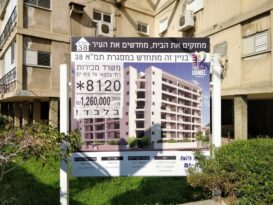According to CBS data today (Wed), Tel Aviv continues to lead in terms of the number of homes rented in Israel with 104,000 units comprising 47.4% of the city’s housing. 60% of homes held by those aged 34 and under – are rentals.
By Doron Breutman, Nadlan Center
Even in 2024, and in light of the rise in home prices in Israel, the increase in rental homes and the decrease in owner-occupied homes continues. According to data released today (Wed) by the Central Bureau of Statistics (CBS), as of July 2024, there were 2.96 million residential homes in Israel. Of these, 2.1 million homes, 70.6% of all homes, are owner-occupied, and about 851,000 homes, which are 28.8% of all homes, are rented. About 17,500 homes are private sheltered accommodations (0.6%).
Compared to data from a year ago, there was a minor change with a decrease of 0.2 percentage points in the ownership rate and a similar increase in the rental rate. Over time, however, the changes are more significant. For comparison, in 2013, the earliest year for which CBS data exists, the ownership rate was 75.2%, while the rental rate was 24.3%.
A breakdown by district shows that the highest ownership rate is in the Northern District (79.5%) and Judea and Samaria (77.9%), followed by the Central District (73.3%), Haifa District (70.6%), the South (70.3%), Jerusalem (68.6%) and the lowest – Tel Aviv District (60.4%). Correspondingly, the highest rental rate is in the Tel Aviv District (39.1%), compared to 22.2% in Judea and Samaria and 20.4% in the Northern District.
The data also shows that 60.5% of rental homes are in the nineteen largest cities with populations of 100,000 or more. Tel Aviv-Yafo alone holds 12.2% of all homes rented in Israel (104,000 homes), followed by Jerusalem with 9.2% (78,500 homes), Haifa with 5.4% (45,960 homes), and Be’er Sheva with 3.2% (27,800 homes).
Mitzpe Ramon has the highest proportion of rental homes
A breakdown of rented homes as a share of total homes in each locality shows that in Mitzpe Ramon, 55.8% of homes are rented—the highest rate. Next is the city of Harish where 51.8% of homes are rented, Tel Aviv-Yafo where 47.4% are rented, Kiryat Arba with 43.6%, Givatayim with 41.8%, and Ramat Gan with 40%.
Regarding demographic characteristics, among all homes, only 14% are held by Arabs, while 76.6% are held by Jews. The rest are held by the “Others” group, defined as non-Arab Christians, individuals not classified by religion in the population registry, or those with unknown nationality (e.g., foreign residents or companies). Among homes held by Jews, 69.5% are owned, 30% are rented, and 0.6% are in private sheltered housing. Among homes held by Arabs, 87.7% are owned, and 12.3% are rented.
Additionally, age group data shows that the older the age group, the higher the share of owner-occupied homes and the lower the share of rentals. Among homes held by those aged up to 34, 59.6% are rented, compared to about 17.9% among those aged 65 and above. Between 2013–2024, the share of rentals among those up to age 64 rose from 27.9% to 35%. Among those aged 65 and above, the rental rate remained constant (around 18%).
Additional CBS data pertains to public housing, defined by the Ministry of Construction and Housing as “a housing solution for households unable to buy or rent in the private market.” According to the data, since 2013, there has been a gradual decline in the number of public housing units. In 2013, there were 56,500 public housing units, while in 2024 there are 45,500.
CBS notes that since 2013, about 1,000 units have been removed annually from the public housing inventory. However, regarding public sheltered accommodation for eligible immigrants aged 65 and older, there has been an increase. In 2013, there were 10,600 such units, while in 2024, the number stands at 14,600.

Nadlan Center is Israel’s leading real estate news and knowledge platform in Hebrew, created for industry professionals. Founded by experts in the field, it delivers in-depth, up-to-date coverage on urban renewal, planning and construction, taxation, and housing policy — tailored to the needs of developers, investors, planners, and financiers. In addition to its widely read news content, Nadlan Center hosts major industry events, professional conferences, and training programs that support the growth and development of the Israeli real estate sector.
Learn more: https://www.nadlancenter.co.il







